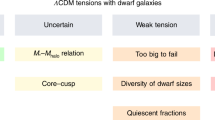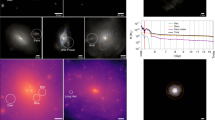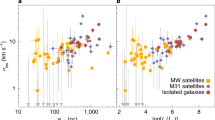Abstract
Dwarf spheroidal galaxies provide well-known challenges to the standard cold and collisionless dark matter scenario1,2: the too-big-to-fail problem (namely the mismatch between the observed mass enclosed within their half-light radius3,4 and cold dark matter N-body predictions5,6) and the hints for inner constant-density cores7,8,9,10. While these controversies may be alleviated by baryonic physics and environmental effects11,12,13,14,15, revisiting the standard lore of cold and collisionless dark matter remains an intriguing possibility. Self-interacting dark matter16,17 may be the successful proposal to such a small-scale crisis18,19. Self-interactions correlate dark matter and baryon distributions, allowing for constant-density cores in low-surface-brightness galaxies20,21,22,23. Here, we perform a data-driven study of the too-big-to-fail problem of Milky Way dwarf spheroidals within the self-interacting dark matter paradigm. We find a good description of their stellar kinematics and compatibility with the concentration–mass relation from the pure cold dark matter simulation in ref. 24. Within this concentration–mass relation, a subset of Milky Way dwarfs are well fitted by cross-sections of 0.5–3.0 cm2 g−1, while others point to values greater than 10 cm2 g−1.
This is a preview of subscription content, access via your institution
Access options
Access Nature and 54 other Nature Portfolio journals
Get Nature+, our best-value online-access subscription
$29.99 / 30 days
cancel any time
Subscribe to this journal
Receive 12 digital issues and online access to articles
$119.00 per year
only $9.92 per issue
Buy this article
- Purchase on Springer Link
- Instant access to full article PDF
Prices may be subject to local taxes which are calculated during checkout



Similar content being viewed by others
References
Tulin, S. & Yu, H.-B. Dark matter self-interactions and small scale structure. Phys. Rep. 730, 1–57 (2018).
Bullock, J. S. & Boylan-Kolchin, M. Small-scale challenges to the ΛCDM paradigm. Annu. Rev. Astron. Astr. 55, 343–387 (2017).
Walker, M. G. et al. A universal mass profile for dwarf spheroidal galaxies? Astrophys. J. 704, 1274–1287 (2009).
Wolf, J. et al. Accurate masses for dispersion-supported galaxies. Mon. Not. R. Astron. Soc. 406, 1220–1237 (2010).
Boylan-Kolchin, M., Bullock, J. S. & Kaplinghat, M. Too big to fail? The puzzling darkness of massive Milky Way subhaloes. Mon. Not. R. Astron. Soc. 415, L40–L44 (2011).
Boylan-Kolchin, M., Bullock, J. S. & Kaplinghat, M. The Milky Way’s bright satellites as an apparent failure of ΛCDM. Mon. Not. R. Astron. Soc. 422, 1203–1218 (2012).
Battaglia, G. et al. The kinematic status and mass content of the Sculptor dwarf spheroidal galaxy. Astrophys. J. 681, L13 (2008).
Amorisco, N. C. & Evans, N. W. Dark matter cores and cusps: the case of multiple stellar populations in dwarf spheroidals. Mon. Not. R. Astron. Soc. 419, 184–196 (2012).
Walker, M. G. & Peñarrubia, J. A method for measuring (slopes of) the mass profiles of dwarf spheroidal galaxies. Astrophys. J. 742, 20 (2011).
Strigari, L. E., Frenk, C. S. & White, S. D. M. Dynamical models for the Sculptor dwarf spheroidal in a ΛCDM universe. Astrophys. J. 838, 123 (2017).
Pontzen, A. & Governato, F. Cold dark matter heats up. Nature 506, 171–178 (2014).
Sawala, T. et al. The APOSTLE simulations: solutions to the Local Group’s cosmic puzzles. Mon. Not. R. Astron. Soc. 457, 1931–1943 (2016).
Dutton, A. A. et al. NIHAO V: too big does not fail—reconciling the conflict between ΛCDM predictions and the circular velocities of nearby field galaxies. Mon. Not. R. Astron. Soc. 457, L74–L78 (2016).
Wetzel, A. R. et al. Reconciling dwarf galaxies with ΛCDM cosmology: simulating a realistic population of satellites around a Milky Way-mass galaxy. Astrophys. J. Lett. 827, L23 (2016).
Fattahi, A. et al. The cold dark matter content of Galactic dwarf spheroidals: no cores, no failures, no problem. Preprint at https://arxiv.org/abs/1607.06479 (2016).
Spergel, D. N. & Steinhardt, P. J. Observational evidence for self-interacting cold dark matter. Phys. Rev. Lett. 84, 3760–3763 (2000).
Kaplinghat, M., Tulin, S. & Yu, H.-B. Dark matter halos as particle colliders: a unified solution to small-scale structure puzzles from dwarfs to clusters. Phys. Rev. Lett. 116, 041302 (2016).
Vogelsberger, M., Zavala, J. & Loeb, A. Subhaloes in self-interacting galactic dark matter haloes. Mon. Not. R. Astron. Soc. 423, 3740–3752 (2012).
Rocha, M. et al. Cosmological simulations with self-interacting dark matter I: constant density cores and substructure. Mon. Not. R. Astron. Soc. 430, 81–104 (2013).
Kaplinghat, M., Keeley, R. E., Linden, T. & Yu, H.-B. Tying dark matter to baryons with self-interactions. Phys. Rev. Lett. 113, 021302 (2014).
Elbert, O. D. et al. Core formation in dwarf halos with self interacting dark matter: no fine-tuning necessary. Mon. Not. R. Astron. Soc. 453, 29–37 (2015).
Kamada, A., Kaplinghat, M., Pace, A. B. & Yu, H.-B. How the self-interacting dark matter model explains the diverse galactic rotation curves. Phys. Rev. Lett. 119, 111102 (2017).
Creasey, P. et al. Spreading out and staying sharp—creating diverse rotation curves via baryonic and self-interaction effects. Mon. Not. R. Astron. Soc. 468, 2283 (2017).
Vogelsberger, M. et al. ETHOS—an effective theory of structure formation: dark matter physics as a possible explanation of the small-scale CDM problems. Mon. Not. R. Astron. Soc. 460, 1399–1416 (2016).
Battaglia, G., Helmi, A. & Breddels, M. Internal kinematics and dynamical models of dwarf spheroidal galaxies around the Milky Way. New Astron. Rev. 57, 52–59 (2013).
Navarro, J. F., Frenk, C. S. & White, S. D. M. A universal density profile from hierarchical clustering. Astrophys. J. 490, 493–508 (1997).
Burkert, A. The structure of dark matter halos in dwarf galaxies. Astrophys. J. 447, L25 (1995).
Baes, M. & Van Hese, E. Dynamical models with a general anisotropy profile. Astron. Astrophys. 471, 419–432 (2007).
Zavala, J., Vogelsberger, M. & Walker, M. G. Constraining self-interacting dark matter with the Milky Way’s dwarf spheroidals. Mon. Not. R. Astron. Soc. 431, L20–L24 (2013).
Peñarrubia, J. et al. The impact of dark matter cusps and cores on the satellite galaxy population around spiral galaxies. Mon. Not. R. Astron. Soc. 406, 1290–1305 (2010).
Garrison-Kimmel, S., Boylan-Kolchin, M., Bullock, J. S. & Kirby, E. N. Too big to fail in the Local Group. Mon. Not. R. Astron. Soc. 444, 222–236 (2014).
Papastergis, E., Giovanelli, R., Haynes, M. P. & Shankar, F. Is there a “too big to fail” problem in the field? Astron. Astrophys. 574, A113 (2015).
Geringer-Sameth, A., Koushiappas, S. M. & Walker, M. G. Dwarf galaxy annihilation and decay emission profiles for dark matter experiments. Astrophys. J. 801, 74 (2015).
Plummer, H. C. On the problem of distribution in globular star clusters. Mon. Not. R. Astron. Soc. 71, 460–470 (1911).
McConnachie, A. W. The observed properties of dwarf galaxies in and around the Local Group. Astron. J. 144, 4 (2012).
Bonnivard, V., Combet, C., Maurin, D. & Walker, M. G. Spherical Jeans analysis for dark matter indirect detection in dwarf spheroidal galaxies—impact of physical parameters and triaxiality. Mon. Not. R. Astron. Soc. 446, 3002–3021 (2015).
An, J. H. & Evans, N. W. A cusp slope—central anisotropy theorem. Astrophys. J. 642, 752–758 (2006).
An, J., Van Hese, E. & Baes, M. Phase–space consistency of stellar dynamical models determined by separable augmented densities. Mon. Not. R. Astron. Soc. 422, 652–664 (2012).
Strigari, L. E. et al. A common mass scale for satellite galaxies of the Milky Way. Nature 454, 1096–1097 (2008).
Campbell, D. J. R. et al. Knowing the unknowns: uncertainties in simple estimators of galactic dynamical masses. Mon. Not. R. Astron. Soc. 469, 2335–2360 (2017).
González-Samaniego, A. et al. Dwarf galaxy mass estimators vs. cosmological simulations. Mon. Not. R. Astron. Soc. 472, 4786–4796 (2017).
Ullio, P. & Valli, M. A critical reassessment of particle dark matter limits from dwarf satellites. J. Cosmol. Astropart. Phys. 1607, 025 (2016).
Strigari, L. E., Koushiappas, S. M., Bullock, J. S. & Kaplinghat, M. Precise constraints on the dark matter content of Milky Way dwarf galaxies for gamma-ray experiments. Phys. Rev. D 75, 083526 (2007).
Charbonnier, C. et al. Dark matter profiles and annihilation in dwarf spheroidal galaxies: prospectives for present and future gamma-ray observatories—I. The classical dSphs. Mon. Not. R. Astron. Soc. 418, 1526–1556 (2011).
Bonnivard, V. et al. Dark matter annihilation and decay in dwarf spheroidal galaxies: the classical and ultrafaint dSphs. Mon. Not. R. Astron. Soc. 453, 849–867 (2015).
Akaike, H. A new look at the statistical model identification. IEEE Trans. Automat. Contr. 19, 716–723 (1974).
Goodman, J. & Weare, J. Ensemble samplers with affine invariance. Comm. App. Math. Comp. Sci. 5, 65–80 (2010).
Foreman-Mackey, D., Hogg, D. W., Lang, D. & Goodman, J. emcee: the MCMC hammer. Publ. Astron. Soc. Pac. 125, 306 (2013).
Acknowledgements
M.V. acknowledges support from the European Research Council under the European Union’s Seventh Framework Programme (FP/2007–2013)/ERC grant agreement 279972 ‘NPFlavour’. H.-B.Y. acknowledges support from the US Department of Energy under grant number de-sc0008541 and the Hellman Fellows Fund. M.V. and H.-B.Y. are grateful to M. Walker for the binned kinematic dataset adopted in the analysis. They also acknowledge P. Creasey, M. Kaplinghat, M. Petač, L. Sales and P. Ullio for useful discussions, and thank organizers and participants of the stimulating workshops ‘Self-Interacting Dark Matter’ (Niels Bohr Institute) and ‘WIMPs vs non-WIMPs in dwarf spheroidal galaxies’ (University of Turin).
Author information
Authors and Affiliations
Contributions
M.V. performed the required analytical computations and numerical analysis. The original idea of the study is attributed to H.-B.Y., who supervised the work. Both M.V. and H.B.Y. contributed to writing the manuscript.
Corresponding author
Ethics declarations
Competing interests
The authors declare no competing interests.
Additional information
Publisher’s note: Springer Nature remains neutral with regard to jurisdictional claims in published maps and institutional affiliations.
Rights and permissions
About this article
Cite this article
Valli, M., Yu, HB. Dark matter self-interactions from the internal dynamics of dwarf spheroidals. Nat Astron 2, 907–912 (2018). https://doi.org/10.1038/s41550-018-0560-7
Received:
Accepted:
Published:
Issue Date:
DOI: https://doi.org/10.1038/s41550-018-0560-7
This article is cited by
-
Quantum theory of dark matter scattering
Journal of High Energy Physics (2023)
-
Maximally self-interacting dark matter: models and predictions
Journal of High Energy Physics (2020)
-
Direct detection and complementary constraints for sub-GeV dark matter
Journal of High Energy Physics (2020)
-
Displaced lepton jet signatures from self-interacting dark matter bound states
Journal of High Energy Physics (2019)
-
Is dark matter self-interacting?
Nature Astronomy (2018)



